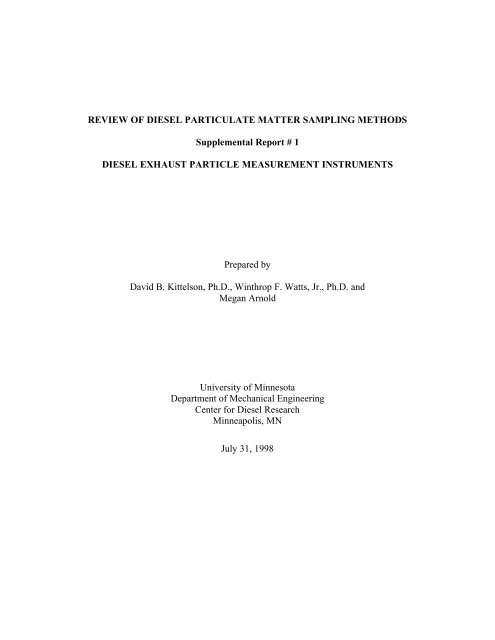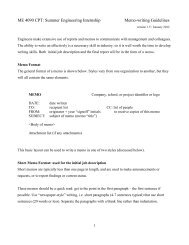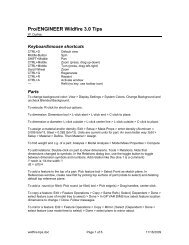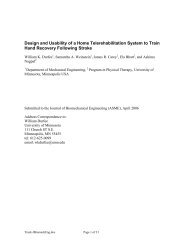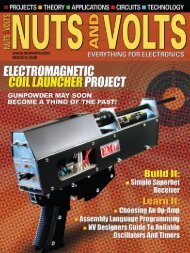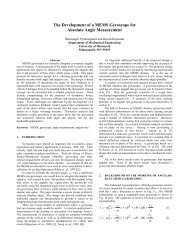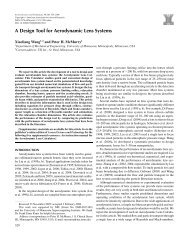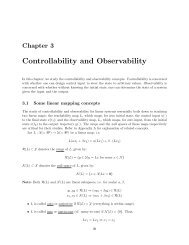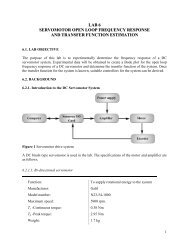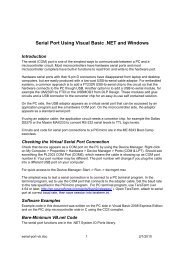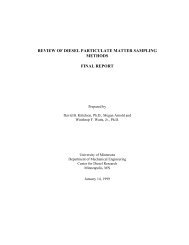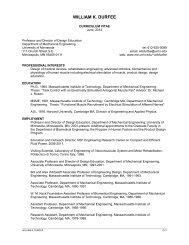Diesel Aerosol Measurement - Department of Mechanical ...
Diesel Aerosol Measurement - Department of Mechanical ...
Diesel Aerosol Measurement - Department of Mechanical ...
Create successful ePaper yourself
Turn your PDF publications into a flip-book with our unique Google optimized e-Paper software.
REVIEW OF DIESEL PARTICULATE MATTER SAMPLING METHODS<br />
Supplemental Report # 1<br />
DIESEL EXHAUST PARTICLE MEASUREMENT INSTRUMENTS<br />
Prepared by<br />
David B. Kittelson, Ph.D., Winthrop F. Watts, Jr., Ph.D. and<br />
Megan Arnold<br />
University <strong>of</strong> Minnesota<br />
<strong>Department</strong> <strong>of</strong> <strong>Mechanical</strong> Engineering<br />
Center for <strong>Diesel</strong> Research<br />
Minneapolis, MN<br />
July 31, 1998
TABLE OF CONTENTS<br />
2<br />
Page<br />
Abstract………….………………………………………………………………….… 3<br />
Introduction…………………………………………………………………………… 3<br />
<strong>Diesel</strong> aerosol size instrumentation…………………………………………………… 4<br />
Inertial mobility instruments…………………………………………………….... 4<br />
Electric mobility instruments……………………………………………………… 5<br />
Photoemission instruments………………………………………………………... 9<br />
Mass spectrometry instruments………………………………………………….... 10<br />
Radioactive tracer instruments…………………………………………………….. 12<br />
Other sizing instruments…………………………………………………………... 12<br />
GM and Ford lab visits……………………………………………………………….... 14<br />
References……………………………………………………………………………... 14<br />
Appendix 1 - Lab survey summary……………………………………………………. 21
ABSTRACT<br />
This report describes instruments used to characterize diesel aerosol, summarizes<br />
information obtained from engine laboratory visits and present results from a diesel<br />
aerosol sampling questionnaire circulated to major engine labs. It is the first<br />
supplemental report to the final project report prepared for the Environmental Protection<br />
Agency (EPA) grant titled “Review <strong>of</strong> <strong>Diesel</strong> Particulate Matter Sampling Methods”.<br />
This report is a revised version <strong>of</strong> a previous project report and is an accompaniment to<br />
Supplemental Report No. 2, titled “<strong>Aerosol</strong> Dynamics and Laboratory and On-Road<br />
Studies” (Kittelson, et al., 1998a) and the final project report (Kittelson, et al., 1998b).<br />
INTRODUCTION<br />
Particle size distribution analysis <strong>of</strong> diesel aerosol can be divided into two principle tasks;<br />
sample collection and sample analysis. The size distribution <strong>of</strong> the aerosol is a function<br />
<strong>of</strong> the chemical and physical processes occurring between the point <strong>of</strong> aerosol generation<br />
and the point <strong>of</strong> aerosol collection. These processes, such as dilution, coagulation,<br />
condensation, homogeneous and heterogeneous nucleation, simultaneously affect the<br />
aerosol size distribution and are not well understood and are discussed in the second<br />
supplemental report. This report focuses on summarizing information on instruments<br />
used for the particle size analysis <strong>of</strong> diesel aerosol.<br />
Instrumentation used for diesel aerosol size characterization is <strong>of</strong> essentially two types;<br />
those that provide size distribution data in real or near real-time and those that collect<br />
samples for subsequent analysis such as gravimetric, chemical or microscopic analysis.<br />
In many instances, the capabilities <strong>of</strong> these instruments are the limiting factor in how<br />
aerosol is sampled. The analytical methods used to characterize the diesel aerosol<br />
chemically and biologically are not covered in this report.<br />
<strong>Aerosol</strong> sizing instruments may be divided into categories based on the measurement<br />
principle. Several issues pertain to the use <strong>of</strong> these instruments. Each instrument<br />
measures some property <strong>of</strong> the aerosol that relates to size, such as electrical mobility,<br />
aerodynamic diameter, optical behavior, inertial mobility, photoelectric emission, mass<br />
spectroscopy, etc. Each <strong>of</strong> these properties is related through analysis to aerosol<br />
parameters such as number, surface area, volume or mass-weighted size distribution. The<br />
investigator using these instruments should be aware <strong>of</strong> issues <strong>of</strong> relating the property<br />
being measured and the final output <strong>of</strong> the instrument. Because the instruments are based<br />
on different particulate properties, results from these instruments may not always be<br />
compared directly. In general, it is not possible to obtain particle size information on the<br />
entire five-decade size range from 0.001 - 100 μm with a single instrument (Baron and<br />
Willeke, 1993). In most instances multiple instruments using different principles <strong>of</strong><br />
operation are required to measure the diesel aerosol size distribution. Finally, many<br />
instruments are calibrated using a precisely controlled aerosol that may cause a different<br />
observed response than the aerosol <strong>of</strong> interest. (Cohen and Hering 1995)<br />
3
Inertial Mobility Instruments<br />
DIESEL AEROSOL SIZE INSTRUMENTATION<br />
Electrostatic Low-Pressure Impactor (ELPI): The ELPI is used extensively in Europe<br />
(Keskinen, et. al. 1992) to measure number distributions in near real-time. It can also be<br />
used as an inertial impactor to obtain mass size distributions by gravimetric analysis. The<br />
ELPI sizes particles by their aerodynamic diameter from about 30 nm to 10 μm diameter.<br />
The ELPI is unlike a conventional inertial impactor in that it charges the particles prior to<br />
entering the impaction stage. Each impaction stage is connected to an electrometer that<br />
detects the current produced by the impacting particles. This current is converted into a<br />
particle concentration in the corresponding size range. This approach allows the<br />
instrument to make essentially real time size distribution measurements with a time<br />
resolution <strong>of</strong> about 2 s. The instrument is very sensitive and can measure ambient aerosol<br />
concentrations. It can also be used to measure size distributions during transient<br />
laboratory tests.<br />
However, some uncertainties regarding calibration have been reported. In recent<br />
calibration experiments in United Kingdom comparing the ELPI with a scanning mobility<br />
particle sizer (SMPS – discussed below), the ELPI measured lower concentrations and<br />
larger particle diameters in the submicron diameter range (Dickens, et. al. 1997, Moon<br />
and Donald 1997). However, measurements made at the University <strong>of</strong> Birmingham and<br />
at the University <strong>of</strong> Minnesota show better agreement between the ELPI and SMPS<br />
(Keskinen, et. al. 1992) and more recently, measurements made by the Ford Motor<br />
Company also show good correlation between the ELPI and the SMPS (Maricq, 1998).<br />
Calibration difficulties in the upper end <strong>of</strong> the ELPI size range have also been reported by<br />
AEA laboratory in the United Kingdom. Another problem with the instrument is the<br />
rather high lower size cut<strong>of</strong>f <strong>of</strong> 30 nm. This is too large to detect the bulk <strong>of</strong> nanometer<br />
particles produced by new technology engines. The lower size limit is further<br />
compromised by the fact that the last few stages operate at rather low pressures (33, 17,<br />
and 8 kPa for channel midpoints <strong>of</strong> 115, 69, and 40 nm, respectively) that might result in<br />
evaporation <strong>of</strong> semi-volatile particles. Despite these limitations the ELPI is used for<br />
diesel particulate measurements because it is a versatile instrument, capable <strong>of</strong> spanning a<br />
wide range <strong>of</strong> particle size and concentration, in real-time, producing both number and<br />
volume size distributions. In particular, the ELPI is quite useful because it provides<br />
information over a wide size range, 30 nm to 10 μm.<br />
Micro-Orifice Uniform Deposit Impactor (MOUDI): The MOUDI (Marple, et. al.<br />
1991) is a 10 stage impactor with the four lower stages having micro-orifice impaction<br />
plates. The cut points at the nominal flow rate <strong>of</strong> 30 L/min are 10, 5.62, 3.16, 1.78, 1.0,<br />
0.56, 0.316, 0.178, 0.10 and 0.056 μm in aerodynamic diameter and uniform deposition is<br />
achieved by rotating the impaction plates using a motorized turner. The total pressure<br />
drop across the impactor is 0.3 atmospheres. Recent work at the University <strong>of</strong><br />
Minnesota and elsewhere suggests that the combustion aerosol nuclei mode is composed<br />
primarily <strong>of</strong> volatile organic material, thus care must be take to avoid evaporative losses<br />
<strong>of</strong> volatile organics, particularly the condensed organic material. The MOUDI is a useful<br />
4
instrument for determining the mass size distribution <strong>of</strong> diesel exhaust because it covers<br />
the entire size range. However, the MOUDI provides no size breakdown <strong>of</strong> aerosols < 50<br />
nm nor does it provide data on the number distribution. Data are obtained after<br />
gravimetric analysis <strong>of</strong> the MOUDI impaction substrates so the MOUDI does not provide<br />
results in real-time. The diesel aerosol is normally diluted 10:1 or more before sampling<br />
to avoid overloading the impactor substrates from higher particulate concentrations.<br />
However, undiluted exhaust can be sampled directly if the sampling times are very short<br />
and care is taken not to overload the impaction substrates.<br />
The MOUDI has been used extensively to determine the size distribution <strong>of</strong> diesel<br />
aerosols in underground mines (Cantrell and Rubow 1993). Underground mine size<br />
distributions are obtained under heavy engine load conditions from engine ranging in size<br />
from 100 to 700 hp. In mines, ambient temperatures span a broad range (45 to 100 o F) as<br />
does humidity (
enter a mobility analyzer section <strong>of</strong> the EAA. The mobility analyzer functions as a lowpass<br />
filter, precipitating particles having high electrical mobility. Varying the applied<br />
voltage within the mobility analyzer allows the electrical mobility pass cut-point to be<br />
varied. The concentrations <strong>of</strong> particles that pass through the mobility analyzer are<br />
determined by measuring the current carried by the charged particles using an<br />
electrometer mounted downstream <strong>of</strong> the mobility analyzer section. Assuming that the<br />
electrical mobility <strong>of</strong> the sampled particles is a monotonic function <strong>of</strong> particle size,<br />
particle size cutpoints can be determined for each electrical mobility delineated by<br />
mobility analyzer voltage. A particle-size distribution can thus be generated by stepping<br />
the mobility analyzer through 11 voltages and measuring the current carried by the<br />
particles with an electrometer. A preclassification stage, such as an impactor or cyclone,<br />
must be used when sampling diesel exhaust in order to prevent the introduction <strong>of</strong><br />
measurement errors from particles larger than 1.0 μm (Yeh, 1993).<br />
The measured particle-size range <strong>of</strong> the EAA is nominally from 3.2 nm to 1.0 μm, but it<br />
is effectively 10 nm to 0.5 μm. The sensitivity <strong>of</strong> the EAA drops <strong>of</strong>f dramatically below<br />
10 nm (Liu and Pui 1974a), due to diffusional particle losses and incomplete particle<br />
charging. The result is that the electrometer current for the first two voltage steps, which<br />
correspond to the 3.2 nm to 5.6 nm and 5.6 nm to 10 nm electrical mobility size ranges,<br />
respectively, contains only random signal noise unless extremely high particle number<br />
concentrations are present in those size intervals.<br />
Approximately 2 to 3 minutes are required for the EAA to cycle through the 11 voltage<br />
steps. The time required for the voltage stepping poses a limit in using the EAA to<br />
measure the size distribution <strong>of</strong> a rapidly varying aerosol. The integral nature <strong>of</strong> EAA<br />
size measurement can also introduce errors if particle number concentrations change<br />
within the time interval <strong>of</strong> a single scan <strong>of</strong> EAA voltages. This has typically precluded<br />
the use <strong>of</strong> the EAA over transient speed and engine load test cycles such as the U.S. EPA<br />
Heavy-Duty Transient Test (40 CFR 86, Subpart N) without some means <strong>of</strong> collecting or<br />
integrating the particles over the cycle prior to analysis by the EAA. Hammerle, et al.<br />
(1994) and Dolan, et al. (1980) used bag samples to collect particles over transient test<br />
cycles for later size analysis by the EAA. Particle losses <strong>of</strong> up to 50% after 20 minutes<br />
were reported by Hammerle et al (1994).<br />
<strong>Diesel</strong> aerosol measurements with the EAA typically necessitate the use <strong>of</strong> relatively high<br />
dilution <strong>of</strong> diesel exhaust samples (300:1 to 1000:1) to prevent electrometer saturation.<br />
Although similar ranges <strong>of</strong> dilution have been reported for roadside dilution <strong>of</strong> vehicle<br />
exhaust, typical laboratory dilution tunnels operate with dilution ratios ranging from<br />
approximately 10:1 to 20:1, necessitating additional dilution <strong>of</strong> the exhaust sample prior<br />
to entering the EAA (Baumgard and Kittelson 1985), (Baumgard and Johnson 1992),<br />
(Bagley, et. al. 1996).<br />
The EAA requires a very steady concentration to produce accurate size distributions. If<br />
concentration shifts during a measurement, the instrument interprets that as an increased<br />
or reduced concentration in the size being measured at the time <strong>of</strong> the transient, even if<br />
the change is due to something occurring in another size range. The EAA has been<br />
6
largely superceded by the SMPS (described below) because it is susceptible to<br />
measurement error <strong>of</strong> this type. However, it still provides useful measurements when<br />
properly applied. Furthermore, it provides a useful link to a body <strong>of</strong> work done over the<br />
past 20 years.<br />
Differential Mobility Particle Sizer (DMPS): The DMPS (Pui and Swift 1995) also<br />
sizes particles by electrical mobility using an electrical mobility analyzer. Sampled<br />
particles are exposed to a bipolar charger (rather than the unipolar charger <strong>of</strong> the EAA).<br />
The charged particles enter a mobility analyzer section <strong>of</strong> the DMPS and rather than<br />
acting as an integrating low-pass filter, only particles with a specific range <strong>of</strong> electric<br />
mobility are allowed to pass through the differential mobility analyzer and be measured.<br />
The applied voltage within the mobility analyzer is varied by discrete steps that allows<br />
the electrical mobility size interval to be varied. This technique is capable <strong>of</strong> higher<br />
resolution than the EAA, but measurement sensitivity using an electrometer is decreased.<br />
This is due to a smaller interval <strong>of</strong> particles leaving the analyzer, resulting in a smaller<br />
current flow to the electrometer. To avoid this reduction in sensitivity, the DMPS is<br />
typically operated with a high sensitivity condensation nuclei counter or condensation<br />
particle counter rather than an electrometer.<br />
A preclassification stage, such as an impactor or cyclone, must be used when sampling<br />
diesel exhaust in order to prevent the introduction <strong>of</strong> measurement errors from particles<br />
larger than 1.0 μm (Yeh, 1993).<br />
Scanning Mobility Particle Sizer (SMPS): The most common instrument in use for<br />
sizing engine exhaust in the submicrometer diameter region is the SMPS. This<br />
instrument is being used extensively in diesel engine test laboratories in the U.S. and<br />
Europe. It sizes particles by their electrical mobility equivalent diameter in the range<br />
from about 10 to 700 nm diameter. The lower limit can be extended to about 7 nm, but<br />
the uncertainty factor increases significantly. Although the SMPS can complete a scan <strong>of</strong><br />
100 size intervals in 30 s, results are distorted. Sampling times <strong>of</strong> 1-min per distribution<br />
still are subject to some distortion in shape. Size distributions obtained over 2 – 4 min<br />
are more typical <strong>of</strong> normal operating times and result in distributions with little distortion.<br />
The relatively slow scan time <strong>of</strong> the SMPS make it difficult to obtain size distributions<br />
under transient cycle conditions.<br />
The SMPS consists <strong>of</strong> a pre-classification stage (such as an impactor or cyclone), used<br />
when sampling diesel exhaust in order to prevent the introduction <strong>of</strong> measurement errors<br />
from particles larger than 1.0 μm, a DMA for particle classification, and a condensation<br />
nuclei counter (CNC) for particle counting.<br />
The SMPS and similar instrumentation such as the scanning electrical mobility<br />
spectrometer (SEMS) (Wang and Flagan 1990), use continuous scans <strong>of</strong> mobility<br />
analyzer voltage rather than voltage stepping used by other instruments such as the EAA.<br />
The use <strong>of</strong> a low residence time, counting-type condensation nuclei counter (CNC)<br />
allows rapid, high resolution determination <strong>of</strong> submicrometer particle size distributions.<br />
The voltage <strong>of</strong> the mobility analyzer is ramped exponentially. The resultant monotonic<br />
7
variation <strong>of</strong> the electric field strength in the mobility analyzer causes a monotonic<br />
variation in the electrical mobility <strong>of</strong> the particles entering the particle collection slot.<br />
After allowances are made for particle residence times, the entire size distribution can be<br />
derived from a single scan. Scans <strong>of</strong> 100 particle-size intervals can be completed in 30 s.<br />
Scanning the voltage both up and down to generate two size distribution measurements<br />
can be completed in 60 s. Because the voltage is scanned rather than stepped, the number<br />
<strong>of</strong> size intervals is primarily limited by particle residence time and the speed at which the<br />
particles can be counted by the CNC (Keady, et. al. 1983), Pollack counter (Hoppel 1978)<br />
or electrometer (Liu and Pui 1974) (Winklmayr, et. al. 1991). The size interval is<br />
therefore defined by number counts over a voltage interval within the mobility analyzer<br />
voltage scan, thus the operating characteristics <strong>of</strong> the SMPS are dependent upon the<br />
particle counter being used.<br />
The SMPS can also be run in a single size mode as well as in a scanning mode. In the<br />
single size mode it measures a single particle size range continuously with a time<br />
resolution <strong>of</strong> a few seconds. In this mode it can be used for transient particle size<br />
measurements, one size range at a time (Greenwood, et. al. 1996). EMPA, Ford, and<br />
AEA are using this approach, although Ford has not applied the technique to diesel<br />
exhaust. The problem with this approach is that only one size range at a time is measured<br />
when a minimum <strong>of</strong> 3 to 5 size ranges are required to approximately describe the<br />
submicrometer size distribution. Therefore at least 3 to 5 transient tests are required to<br />
obtain one size distribution, which makes the approach time consuming and expensive.<br />
Alternatively, several instruments used in parallel, each measuring a different size, can be<br />
used, but this requires a large investment in instruments.<br />
Size distribution measurements with the SMPS will be biased if particle concentration or<br />
size changes during the time interval <strong>of</strong> the scan. This has typically precluded the use <strong>of</strong><br />
the SMPS over transient speed and engine load test cycles such as the U.S. EPA Heavy-<br />
Duty Transient Test without some means <strong>of</strong> providing a steady aerosol sample stream<br />
during the SMPS scan. A bag sampler that quickly fills and then allows an integrated,<br />
essentially constant, aerosol sample to be withdrawn during the SMPS scan could be<br />
used. Bag samples have been used to collect particles during transient test cycles and for<br />
on-highway studies (Chen, et al. 1984, Keady, et al., 1983 and Kapadia, 1980) and if<br />
losses are characterized and analysis times minimized, this approach may essentially<br />
eliminate this problem.<br />
[Authors’ Note: Based on conversations with the manufacturer <strong>of</strong> the SMPS (Havlicek,<br />
1998), versions 2.0 and 2.1 <strong>of</strong> the SMPS s<strong>of</strong>tware contained an error that caused number<br />
counts <strong>of</strong> nanoparticles less than 10 μm to be inaccurately high with CPC models 3022A<br />
and 3025A. The error has been corrected with the s<strong>of</strong>tware version 2.3 and the<br />
manufacturer has distributed this version to owners <strong>of</strong> affected systems. Data generated<br />
by the SMPS is stored as raw data, allowing previous aerosol measurements performed<br />
with the inaccurate s<strong>of</strong>tware version to be corrected with the updated s<strong>of</strong>tware. Although<br />
the error with SMPS may have caused inaccurately high number concentrations <strong>of</strong><br />
nanoparticles, results from studies <strong>of</strong> diesel exhaust with the correct SMPS s<strong>of</strong>tware<br />
8
(Abdul-Khalek, 1998) and other instruments (Bagley, 1996) still indicate the existence <strong>of</strong><br />
a large nuclei mode <strong>of</strong> exhaust particles under certain conditions.]<br />
Both the SMPS and EAA require a preclassifier to remove supermicron particles. The<br />
SMPS can operate at lower dilution ratios than EAA, such as the 10 - 30:1 ratios typically<br />
found in dilution tunnels. However, under these conditions the instrument fouling<br />
becomes a concern. The SMPS operates most effectively at dilution ratios <strong>of</strong> around<br />
100:1 for typical diesel exhaust aerosols. Here is an example <strong>of</strong> how instruments used to<br />
obtain the aerosol size distribution affect the conditions under which the aerosol is<br />
collected. The size distributions obtained under 30:1 dilution may be quite different from<br />
those obtained from 1,000:1.<br />
Nanometer Differential Mobility Analyzer (nano-DMA): A new, nanometer differential<br />
mobility analyzer (nano-DMA) (Chen and Pui 1997) (Chen, et. al. 1996, 1998)<br />
(Hummes, et. al. 1996), optimized for nanometer size particles, scans the voltage over a<br />
narrower range <strong>of</strong> voltages and particle sizes. Using this narrow range voltage scanning, a<br />
CPC, and a flow geometry that minimizes residence time and diffusional losses, scans <strong>of</strong><br />
particle size between 3 - 50 nm can be completed at high resolution in approximately 10<br />
seconds. This particle size range roughly corresponds to the complete nuclei-mode <strong>of</strong><br />
DPM. The nano-DMA is still in the experimental stage and has not been completely<br />
characterized and is not yet available commercially.<br />
Photoemission <strong>Aerosol</strong> Instruments<br />
It has been recognized that the chemical composition <strong>of</strong> a diesel particle might influence<br />
its health impact when deposited in the human lung. Unburned hydrocarbons, such as<br />
polycyclic aromatic hydrocarbons (PAH’s), from incomplete combustion are recognized<br />
as potent mutagens and carcinogens. Historically, analysis <strong>of</strong> the PAH content <strong>of</strong> diesel<br />
particle matter has been by particle collection on filters, extraction <strong>of</strong> the soluble organic<br />
fraction and PAH identification. Prolonged sampling times are required to obtain<br />
sufficient mass for analysis and this introduces potential errors through artifact formation.<br />
However, this method quantifies specific PAH compounds as illustrated by research at<br />
MTU (Bagley, et al., 1996.)<br />
<strong>Aerosol</strong> photoemission sensors have been developed for in-situ measurement <strong>of</strong> total<br />
particle bound PAH’s and provide an alternative method for PAH quantification<br />
(Burtscher and Siegmann 1993) .<br />
Photoelectric <strong>Aerosol</strong> Sensor (PAS): <strong>Aerosol</strong> photoelectric sensors (Burtscher and<br />
Siegmann 1993, Burtscher, et. al. 1993, Hart, et. al. 1993) have been used to quantify the<br />
total PAH content associated with diesel particulate matter. In a typical configuration for<br />
a PAS, the aerosol passes through an electrical condenser that removes any charged<br />
particles or ions. The remaining neutral particles pass through a photoemission chamber<br />
where they are irradiated with an UV laser or flash lamp. Particles with photoelectric<br />
work functions below the photon energy <strong>of</strong> the UV source emit electrons and become<br />
positive ions (Weiss 1997). The photoemission chamber has a small electric field that<br />
9
precipitates out the high mobility electrons and negative ions. The positive particles are<br />
collected on a filter and the resulting current measured by an electrometer. The intensity<br />
<strong>of</strong> the particle photoemission is linearly related to the amount <strong>of</strong> particle-bound PAH’s<br />
and the particle surface area (Burtscher and Siegmann 1993).<br />
PAS instruments measure the photoemission from particles which is related to particle<br />
surface and gives a surface area concentration. Results from the studies cited are all<br />
reported as photoemission intensity over time. More details on the relation <strong>of</strong><br />
photoemission to PAH concentration, determined by chemical analysis are given<br />
elsewhere (Hart, et al., 1993).<br />
Only submicrometer particles may be irradiated and charged. Particles larger than 1 μm<br />
are removed from the aerosol before it enters the photoemission chamber because they<br />
cannot be charged efficiently. Lower particle size limits and concentration limits for the<br />
PAS instruments have not been reported. This method does not quantify individual PAH<br />
compounds. The detection limit is about 1 ng/m 3 with a time resolution <strong>of</strong> about 1s<br />
(Burtscher and Siegmann 1993).<br />
Mass Spectroscopy Instruments<br />
Mass spectroscopy has been used for decades to characterize the composition <strong>of</strong> aerosol<br />
particles. In principle, a particle is pulsed with a laser that desorbs/ionizes material that is<br />
measured by a mass spectrometer, indicating the chemical components <strong>of</strong> the particle<br />
(Gard, et. al. 1997, Noble and Prather 1996). Mass spectroscopy has an advantage over<br />
the photoemission method discussed above because it gives information for individual<br />
chemical components rather than total PAH content.<br />
Two time-<strong>of</strong>-flight mass spectrometers are described below. While the instruments<br />
provide information on the chemical composition <strong>of</strong> particles, neither instrument is<br />
currently capable <strong>of</strong> providing size resolved chemical characterization in the lower end <strong>of</strong><br />
the accumulation mode or the nuclei mode <strong>of</strong> diesel exhaust aerosols.<br />
<strong>Aerosol</strong> Time-<strong>of</strong>-Flight Mass Spectrometer (ATOFMS): The ATOFMS (Noble and<br />
Prather 1996 and 1998, Gard, et. al. 1997, Silva and Prather 1997) is unique in that it<br />
provides both real-time measurement <strong>of</strong> aerodynamic size and chemical composition <strong>of</strong><br />
individual particles from a polydisperse aerosol. The instrument can analyze up to 600<br />
particles per minute and can measure particles down to 0.3 μm in diameter.<br />
A particle enters the ATOFMS and is accelerated to terminal velocity by supersonic<br />
expansion <strong>of</strong> the carrier gas. Smaller particles reach a higher velocity than larger<br />
particles. The aerodynamic diameter is then determined by time-<strong>of</strong>-flight between two<br />
lasers before the particle enters the ionizing region <strong>of</strong> the mass spectrometer. Each<br />
particle is then pulsed by a laser. The resulting ions and molecules that are<br />
desorbed/ionized from the particle by the laser are measured by a mass spectrometer,<br />
indicating chemical components <strong>of</strong> the desorbed or ionized material. The spectrometer<br />
10
includes two oppositely charged reflectrons that measure both positive and negative ions<br />
and provides good characterization <strong>of</strong> inorganics and light and heavy organics.<br />
Silva and Prather (1997) found the chemical composition <strong>of</strong> exhaust particles to be<br />
related to the size <strong>of</strong> the particle being measured and attribute this to the formation<br />
mechanism <strong>of</strong> the particle. Larger automobile exhaust particles were found to be<br />
inorganic while smaller particles were found to be mainly organic. However, all the<br />
particles measured by the ATOFMS in this study were in the accumulation mode and the<br />
nuclei mode particles were not characterized. They also reported finding platinum,<br />
cerium, and molybdenum in exhaust particles.<br />
ATOFMS is an evolution from earlier mass spectral analysis <strong>of</strong> individual particles called<br />
laser microprobe mass spectrometry (LMMS). LMMS uses mass spectroscopy <strong>of</strong><br />
individual particles that are collected on a filter or impactor stage. Sampling times are on<br />
the order <strong>of</strong> 1 particle per minute, so it is not a real-time instrument. Samples are also<br />
subject to deterioration on the collection substrate before measurement (Noble and<br />
Prather 1996). Additional drawbacks <strong>of</strong> LMMS include that results are not reproducible<br />
and the theory <strong>of</strong> ion formation and behavior for the LMMS are not fully developed<br />
(Weiss 1997).<br />
On-Line <strong>Aerosol</strong> Mass Spectrometer: This instrument (Weiss, 1997) is similar in design<br />
to the ATOFMS and also provides both real-time particle sizing and composition<br />
information. The lower limit for aerodynamic sizing is around 0.3 to 0.4 μm because<br />
particles smaller than this do not scatter sufficient light to be measure for aerodynamic<br />
sizing. Particles larger than the upper limit on particle size <strong>of</strong> about 50 μm quickly clog<br />
the extremely small nozzles and orifices in the instrument. The on-line mass<br />
spectrometer can analyze up to 120-600 particles per minute.<br />
The on-line mass spectrometer uses a single ion detector that characterizes inorganic and<br />
lighter organic material well but does not provide adequate resolution for more complex<br />
organics. It has been used to measure the concentration <strong>of</strong> cerium in diesel particulate<br />
matter that had been added to the fuel <strong>of</strong> a DI diesel engine. Metal based fuel additives<br />
such as cerium are added to diesel fuel so as to act as an oxidation catalyst to assist in the<br />
regeneration <strong>of</strong> diesel exhaust filters. Determination <strong>of</strong> the fate <strong>of</strong> these metals in diesel<br />
exhaust adds to the understanding <strong>of</strong> their impact on diesel emissions.<br />
Particle-Beam Mass Spectrometer (PBMS): (Ziemann, 1995, Kittelson, 1998) This<br />
method uses a mass spectrometer to determine the composition <strong>of</strong> the volatile organics<br />
and inorganics <strong>of</strong> particles that have been collected on an electrometer. An aerosol<br />
travels through a differential mobility analyzer that allows only particles <strong>of</strong> a selected<br />
size to pass through. A particle beam is then generated by sending the charged particles<br />
selected by the DMA through a sequence <strong>of</strong> openings that concentrate the particles into a<br />
narrowing beam. The particle beam is then directed at an electrometer that acts as a<br />
particle collector. When sufficient particle mass is collected, the electrometer is heated to<br />
about 200 o C, driving <strong>of</strong>f the volatile organics and inorganics which are analyzed by a<br />
mass spectrometer.<br />
11
This method allows the chemical characterization <strong>of</strong> the diesel particulate matter volatile<br />
material within a specific size. The collection <strong>of</strong> the particles allows sufficient mass for<br />
the mass spectrometry to be performed on nano-particles. There are currently no<br />
published results from this work.<br />
Radioactive Tracer Instruments<br />
The attachment <strong>of</strong> a radioactive tracer to particles allows the measurement <strong>of</strong> particle<br />
radioactivity to be related to particle surface area.<br />
Epiphaniometer: The epiphaniometer (Gaggeler, et. al. 1989a, Gaggeler, et al 1989b) is<br />
an instrument developed at the Paul Scherrer Institute in Switzerland that measures the<br />
surface concentration <strong>of</strong> aerosol particles in both the nuclei and accumulation mode size<br />
ranges. The epiphaniometer is most sensitive to particles in the accumulation mode, but<br />
Gaggeler, et. al. 1989a reported successfully measuring silver particles between 20 and<br />
90 nm that were agglomerates formed from smaller primary silver particles. The<br />
maximum concentrations the epiphaniometer can handle is not reported, but it is capable<br />
<strong>of</strong> measuring low atmospheric particle concentrations found in remote locations.<br />
In an epiphaniometer, aerosol is passed through a charging chamber where lead isotopes<br />
created from a decaying actinium source are attached to the particle surfaces. The<br />
particles are transported through a capillary to a collecting filter. The epiphaniometer<br />
uses a surface barrier detector to measure the level <strong>of</strong> radioactivity <strong>of</strong> the particles<br />
collected on the filter. The amount <strong>of</strong> radioactivity is proportional to the particle’s Fuchs<br />
surface area and follows Fuchs theory <strong>of</strong> attachment <strong>of</strong> radioactive isotopes.<br />
Because <strong>of</strong> the short half-life <strong>of</strong> the lead isotopes, the filter does not become saturated<br />
and essentially real-time radioactivity measurements can be made. Although not clearly<br />
stated in the studies, the surface barrier detector measures radioactivity and must be<br />
related to the size <strong>of</strong> particles being sampled to get a measure <strong>of</strong> surface area <strong>of</strong> the<br />
particles. A pre-classifier, such as a DMA, may be used before the epiphaniometer to<br />
allow a determined range <strong>of</strong> particles to enter the instrument.<br />
Other Sizing Instruments<br />
Other instruments have been applied to exhaust particle measurements by European labs,<br />
especially by AEA where a systematic study <strong>of</strong> a variety <strong>of</strong> instruments has been done<br />
(Dickens, et. al. 1997). These instruments include a quartz crystal substrate impactor, the<br />
Stober centrifuge, and Anderson impactors. Of these, only the quartz crystal impactor<br />
gives near real time measurements. The centrifuge and the Anderson impactor both<br />
require substrate removal and weighing to determine size distributions. The quartz<br />
crystal impactor grossly underestimates the concentrations <strong>of</strong> diesel particles throughout<br />
its operating range. Apparently diesel particles do not couple well with the vibrating<br />
surfaces <strong>of</strong> the quartz substrates. This causes the instrument to underestimate deposited<br />
mass. The U. S. Bureau <strong>of</strong> Mines encountered exactly the same problem many years ago<br />
(Welker, et al, 1982).<br />
12
Ricardo in England has tried to use an aerodynamic particle sizer (APS) for exhaust<br />
particle measurements. This instrument sizes particles by aerodynamic diameter in the<br />
size range from about 0.5 to 10 μm diameter. The problem with using an instrument <strong>of</strong><br />
this type for engine size measurements is that it misses the size range where most <strong>of</strong> the<br />
mass, and even more so, number <strong>of</strong> diesel exhaust particles are found. Furthermore, if<br />
there is a large concentration <strong>of</strong> particles just below the size detection limit <strong>of</strong> the<br />
instrument it can result in a shadow mode just above the lower detection limit <strong>of</strong> the<br />
instrument that is not really there (Baron, Mazumder and Cheng, 1993, Heitbrink, et al.<br />
1991, Baron, 1986).<br />
Diffusion Batteries: Diffusion batteries were developed to determine particle diffusion<br />
coefficients (Cheng 1993), and have been used for size characterization <strong>of</strong> 1 nm to 100<br />
nm aerosols for more than 50 years (DeMarcus and Thomas 1952, Thomas 1955) by<br />
deriving particle size from diffusion characteristics. Diffusion batteries separate particles<br />
by their diffusion mobilities. Mathematical expressions have been derived which<br />
describe particle concentration pr<strong>of</strong>iles for various flow pr<strong>of</strong>iles within, geometries <strong>of</strong>,<br />
screens, tubes, and beads that are commonly used for diffusion batteries (Cheng 1993,<br />
Cheng et al. 1985, Cheng and Yeh 1984). A number <strong>of</strong> numerical inversion techniques<br />
have been applied to the penetration versus particle size <strong>of</strong> polydisperse aerosols within<br />
diffusion batteries <strong>of</strong> varying geometries (Cheng and Yeh 1984, Kapadia 1980, Maher<br />
and Laird 1985, Twomey 1975). Diffusion batteries are typically used with a switching<br />
valve to vary the effective diffusional path length, and a CNC or Pollack counter for<br />
measuring particle number concentrations (Sinclair 1986, Sinclair et al. 1979)<br />
Screen type diffusion batteries are commercially available with switching valves for<br />
varying the effect diffusional length. By switching the valve and counting the particles<br />
using a CNC, a particle size distribution can be obtained between approximately 5 nm<br />
and 0.5 Fm. Switching diffusion batteries have been used to determine particle size vs.<br />
number concentration for diesel PM (Dolan et al. 1980, Baumgard and Kittelson, Clary),<br />
and have typically shown good agreement with electrical mobility sizing methods and<br />
inertial impaction sizing methods over the size ranges that overlap with these types <strong>of</strong><br />
instruments. The time necessary for switching the effective length <strong>of</strong> the diffusion<br />
battery and for CNC measurement limits switching diffusion battery/CNC combinations<br />
to the measurement <strong>of</strong> particle size over relatively steady-state conditions.<br />
Parallel Flow Diffusion Battery (PFDB): A PFDB (Cheng and Yeh 1984, Cheng, et.<br />
al. 1984, Degobert 1988) has been used to measure particle-size in diesel exhaust in the 3<br />
nm to 0.5 μm size range over the light-duty, FTP test cycle using a standard, single<br />
dilution, EPA-style CVS dilution tunnel at dilution ratios <strong>of</strong> approximately 8:1 to 10:1<br />
(Cheng and Yeh 1984). The PFDB uses seven parallel flow paths, each with a varying<br />
number <strong>of</strong> stacked, stainless steel mesh screens followed by a 25 mm Zefluor TM filter.<br />
Critical flow orifices are used to control the sample flow rate through each set <strong>of</strong> stacked<br />
screens and filters. The PFDB was used with a low pressure cascade impactor to allow<br />
classification <strong>of</strong> larger particles and to provide a necessary 0.7 μm preclassification<br />
cutpoint (Cheng and Yeh 1984). A similar device was developed (Boulad and Diouri<br />
13
1988) and used for DPM size characterization (Degobert 1988) with an 8-stage cascade<br />
impactor from 0.35 μm to 7.5 μm, and diffusion battery with 5 parallel bead-beds<br />
covering 8 nm to 0.35 μm. Advantages <strong>of</strong> this type <strong>of</strong> diffusion battery measurement<br />
procedure include; direct filter mass measurement procedures, ability to integrate particle<br />
mass measurements for each size range to be over transient engine operating conditions,<br />
and similarity to actual diffusion-deposition mechanism for fine particles in lung tissue.<br />
Disadvantages include; potential difficulty in resolving the (typically) very small mass<br />
concentration <strong>of</strong> ultra-fine nuclei-mode particles, and errors associated with the data<br />
inversion techniques. It might be possible to combine the parallel diffusion battery<br />
approach with particle detection using CNCs. This would give near real time response,<br />
but would require multiple CNCs.<br />
GM AND FORD LAB VISITS<br />
The investigators recognized that the dilution, sampling procedures and aerosol<br />
instruments used in diesel laboratories determine the aerosol size distributions. With this<br />
in mind, Pr<strong>of</strong>s. Kittelson and Johnson visited the engine laboratories <strong>of</strong> GM and Ford in<br />
Detroit in September, 1997 to gather information on how these organizations were sizing<br />
diesel aerosol.<br />
The Ford laboratory has dual stainless steel CVS type tunnels, one for diesel, one for<br />
gasoline. They are very concerned about condensation in the tunnels. The inlet air is dry<br />
and heated to prevent condensation during cold starts with gasoline engines. Particle<br />
sizing instruments include a SMPS in conjunction with a 3010 CNC and an ELPI. No<br />
secondary dilution is used for gasoline engines and Ford has not tested diesels yet. Since<br />
the SMPS has a 30 s scan time, but can obtain a sample for a single channel in 1 s<br />
transient size distributions are measured by running on 4 consecutive days, each day with<br />
the SMPS set to a different size channel. This is time consuming and expensive. Recent<br />
work reported by Maricq (1998) showed good agreement between the SMPS and ELPI.<br />
Most <strong>of</strong> the engine exhaust particle measurement work at GMR in recent years has been<br />
associated with Coordinating Research Council sponsored field studies, which have<br />
determined particle mass emissions from in-use vehicles. GMR is refurbishing their lab<br />
for particle size measurements. They have a CVS type dilution tunnel operating with<br />
filtered laboratory air. Particle sizing instruments consisted <strong>of</strong> a MOUDI and an EAA.<br />
As a result <strong>of</strong> these lab visits, a questionnaire was prepared and sent to the major engine<br />
labs in the U.S. and Europe to obtain current data. The responses from the questionnaire<br />
are given in Appendix A.<br />
REFERENCES<br />
Baron, P. A. 1986. Calibration and Use <strong>of</strong> the Aerodynamic Particle Sizer (APS 3300).<br />
<strong>Aerosol</strong> Sci. Technol. 5(1): 55-67.<br />
14
Baron, P. and K. Willeke. 1993. Chapter 2 <strong>Aerosol</strong> Fundamentals. In <strong>Aerosol</strong><br />
<strong>Measurement</strong> Principles Techniques and Applications, K. Willeke and P. Baron editors,<br />
Van Nostrand Reinhold, NY, NY., p. 8-22.<br />
Baron, P. A., M. K. Mazumder and Y. S. Cheng. 1993. Chapter 17 Direct Reading<br />
Techniques Using Optical Particle Detection. In <strong>Aerosol</strong> <strong>Measurement</strong> Principles<br />
Techniques and Applications, K. Willeke and P. Baron editors, Van Nostrand Reinhold,<br />
NY, NY., p. 381-409.<br />
Baumgard, K.J. and J. H. Johnson. 1992. The Effect <strong>of</strong> Low Sulfur Fuel and a Ceramic<br />
Particle Filter on <strong>Diesel</strong> Exhaust Particle Size Distributions. Technical Paper Series, No.<br />
920566, SAE: Warrendale, PA.<br />
Baumgard, K.J. and D. B. Kittelson. 1985. The Influence <strong>of</strong> a Ceramic Particle Trap on<br />
the Size Distribution <strong>of</strong> <strong>Diesel</strong> Particles. Technical Paper Series, No. 850009, SAE:<br />
Warrendale, PA.<br />
Bagley, S. T., K. J. Baumgard, L. D. Gratz, J. H. Johnson, and D. G. Leddy. 1996.<br />
Characterization <strong>of</strong> Fuel and Aftertreatment Device Effects on <strong>Diesel</strong> Emissions. Health<br />
Effects Institute Research Report Number 76, 88 pp.<br />
Boulaud, D. and M. Diouri. 1988. A New Inertial and Diffusional Device (SDI 2000). J.<br />
<strong>Aerosol</strong> Sci., Vol. 19(7), pp. 927-930.<br />
Burtscher, H., D. Matter, and D. Steiner. 1993. Characterization <strong>of</strong> Soot Particles by In-<br />
Situ <strong>Measurement</strong> with Different <strong>Aerosol</strong> Analysis Tools. J. <strong>Aerosol</strong> Sci. , Vol. 23, pp.<br />
65-67.<br />
Burtscher, H. and H. C. Siegmann. 1993. Photoemission for In Situ Analysis <strong>of</strong><br />
Particulate Combustion Emissions. Water, Air, and Soil Pol., Vol. 68: 125-136.<br />
Cantrell, B. K. and K. L. Rubow. 1993. <strong>Measurement</strong> <strong>of</strong> <strong>Diesel</strong> Exhaust <strong>Aerosol</strong> in<br />
Underground Coal Mines. Bureau <strong>of</strong> Mines IC 9324, p. 11-17.<br />
Chen, D. R. and D.Y.H Pui. 1997. A Novel Unipolar <strong>Aerosol</strong> Charger. Annual meeting<br />
<strong>of</strong> the AAAR, Denver, CO, October 13-17.<br />
Chen, D. R., D.Y.H. Pui, D. Hummes, H. Fissan, F. R. Quant and G. J. Sem. 1996.<br />
Nanometer Differential Mobility Analyzer (Nano-DMA): Design and Numerical<br />
Modeling. J. <strong>Aerosol</strong> Sci. Vol. 27 Supplement 1 pp. S137-S138.<br />
Chen, D. R., D.Y.H. Pui, D. Hummes, H. Fissan, F. R. Quant and G. J. Sem. 1998.<br />
Design and Evaluation <strong>of</strong> a Nanometer <strong>Aerosol</strong> Differential Mobility Analyzer (Nano-<br />
DMA). J. <strong>Aerosol</strong> Sci. Vol. 29, No. 5/6, pp. 497-509.<br />
15
Cheng, Y.S. 1993. Condensation Detection and Diffusion Size Separation Techniques. In<br />
<strong>Aerosol</strong> <strong>Measurement</strong>, K. Willeke and P.A. Baron, eds. Van Nostrand Rheinhold: New<br />
York, NY, pp. 427-451.<br />
Cheng, Y.S. and C. H. Yeh. 1984. Analysis <strong>of</strong> Screen Diffusion Battery Data. Am. Ind.<br />
Hyg. Assoc. J., 45(8):556-561.<br />
Cheng, Y.S., H. C. Yeh, and K. J. Brinsko. 1985. Use <strong>of</strong> Wire Screens as a Fan Model<br />
Filter. <strong>Aerosol</strong> Sci. Tech., 4:165-174.<br />
Cheng, Y.S., C.H. Yeh, J.L. Mauderly and B. V. Mokler. 1984. Characterization <strong>of</strong><br />
<strong>Diesel</strong> Exhaust in a Chronic Inhalation Study. Am. Ind. Hyg. Assoc. J., 45:547-555.<br />
Clerc, J.C., and J. H. Johnson. 1982. A Computer Heat Transfer and Hydrocarbon<br />
Adsorption Model for Predicting <strong>Diesel</strong> Particulate Emissions in Dilution Tunnels. SAE<br />
Technical Paper Series, No. 821218.<br />
Cohen, B. S. and S.V. Hering (eds.). 1995. Air Sampling Instruments for Evaluation <strong>of</strong><br />
Atmospheric Contaminants. American Conference <strong>of</strong> Governmental Hygienists, Inc.,<br />
651 pp.<br />
Degobert, P. Emissions <strong>Diesel</strong>, Aspects Physico-Chimiques. 1988. 5 ème Symp. Sur la<br />
Recherche en Matière de Pollution Atmosphériqe, Strasbourg, March 22-25, 13 p, (in<br />
French).<br />
DeMarcus, W. and J. W. Thomas. Theory <strong>of</strong> a Diffusion Battery. 1952. Report No.<br />
ORNL-1413, Oak Ridge National Laboratories: Oak Ridge, TN.<br />
Dickens, C. J., M. H. E. Ball, D. Booker, J. R. Donald, A. M. Tope and M. Hughes. 1997.<br />
Evaluation <strong>of</strong> Instruments for Vehicle Emission Particle Sizing. AEA Technology<br />
Report AEAT-1180, 69 pp. (restricted distribution).<br />
Dolan, D.F., D.B. Kittelson, and D.Y.H. Pui. 1980. <strong>Diesel</strong> Exhaust Particle Size<br />
Distribution <strong>Measurement</strong> Techniques. SAE Technical Paper Series, No. 800187.<br />
Dolan, D.F., D. B. Kittelson, and K. T. Whitby. 1975. <strong>Measurement</strong> <strong>of</strong> <strong>Diesel</strong> Exhaust<br />
Particle Size Distributions. Paper No. 75-WA/APC-5, American Society <strong>of</strong> <strong>Mechanical</strong><br />
Engineers: New York, NY.<br />
Fang, C.P., and D. B. Kittelson. 1984. The Influence <strong>of</strong> a Fibrous <strong>Diesel</strong> Particulate Trap<br />
on the Size Distribution <strong>of</strong> Emitted Particles. SAE Technical Paper Series, No. 840362.<br />
Gaggeler, H.W., U. Baltensperger, M. Emmenegger, D. T. Jost, A. Schmidt-Ott, P.<br />
Haller, and M. H<strong>of</strong>mann. 1989a. The Epiphaniometer, A New Device for Continuous<br />
<strong>Aerosol</strong> Monitoring. J. <strong>Aerosol</strong> Sci., Vol. 20, No. 5, pp. 557-564.<br />
16
Gaggeler, H.W., U. Baltensperger, D.T. Jost, M. Emmenegger, and W. Nageli. 1989b.<br />
Applications <strong>of</strong> the Epiphaniometer to Environmental <strong>Aerosol</strong> Studies. J. <strong>Aerosol</strong> Sci.,<br />
Vol. 20, No. 8, pp. 1225-1228.<br />
Gard, E., J.E. Mayer, B. D. Morrical, T. Dienes, D. P. Ferenson, and K. A. Prather. 1997.<br />
Real-time Analysis <strong>of</strong> Individual Atmospheric <strong>Aerosol</strong> Particles: Design and<br />
Performance <strong>of</strong> a Portable ATOFMS. Anal. Chem., Vol. 69, No. 20, pp. 4083-4091.<br />
Greenwood, S.J., J. E. Coxon, T. Biddulph and J. Bennett. 1996. An Investigation to<br />
Determine the Exhaust Particulate Size Distributions for <strong>Diesel</strong>, Petrol, and Compressed<br />
Natural Gas Fuelled Vehicles. SAE Technical Paper Series, No. 961085.<br />
Groblicki, P.J. and C. R. Begeman. 1979. Particle Size Variation in <strong>Diesel</strong> Car Exhaust.<br />
SAE Technical Paper Series, No. 790421.<br />
Hammerle, R. H., D. A. Ketcher, R. W. Horrocks, G. Lepperh<strong>of</strong>f, G. Hüthwohl, and B.<br />
Lüers. 1994. Emissions from Current <strong>Diesel</strong> Vehicles. SAE Technical Paper Series, No.<br />
942043.<br />
Hart, K.M., St. R. McDow, W. Giger, D. Steiner, and H. Burtscher. 1993. The<br />
Correlation Between In-Situ, Real-Time <strong>Aerosol</strong> Photoemission Intensity and Particulate<br />
Polycyclic Aromatic Hydrocarbon Concentration in Combustion <strong>Aerosol</strong>s. Water, Air,<br />
and Soil Pollution, Vol. 68, pp. 75-90.<br />
Havlicek, M. 1998. Personal Communication with M. Arnold. TSI, Inc.<br />
Heitbrink, W. A., P. A. Baron, and K. Willeke. 1991. Coincidence in Time-<strong>of</strong>-flight<br />
Spectrometers: Phantom Particle Creation. <strong>Aerosol</strong> Sci. Technol. 14:112-126.<br />
Hering, S.V. 1995. Impactors, Cyclones, and Other Inertial and Gravitational Collectors.<br />
Ch. 14 in Air Sampling Instruments for Evaluation <strong>of</strong> Atmospheric Contaminants. Ed. by<br />
B. S. Cohen, and S.V. Hering. ACGIH, Cincinnati, OH, 8 th Edition, pp. 279 – 305.<br />
Hoppel, W. A. 1978. Determination <strong>of</strong> the <strong>Aerosol</strong> Size Distribution from the Mobility<br />
Distribution <strong>of</strong> the Charged Fraction <strong>of</strong> <strong>Aerosol</strong>s. J. <strong>Aerosol</strong> Sci., 9:41-54.<br />
Hummes, D., S. Neumann, H. Fissan, D. R. Chen, D. Y. H. Pui, F. R. Quant and G. J.<br />
Sem. 1996. Nanometer Differential Mobility Analyzer (Nano-DMA): Experimental<br />
Evaluation and Performance Verification. J. <strong>Aerosol</strong> Sci. Vol. 27 Supplement 1 pp.<br />
S136-S137.<br />
Keady, P.B., F. R. Quant, G. J. Sem. 1983. TSI Quarterly (9):3.<br />
Kapadia, A. 1980. Data Reduction Techniques for <strong>Aerosol</strong> Size Distribution<br />
<strong>Measurement</strong> Instruments. Ph. D. Dissertation, University <strong>of</strong> Minnesota.<br />
17
Keskinen, J., K. Pietarinen, M. Lehtimaki. 1992. Electrical Low Pressure Impactor. J.<br />
<strong>Aerosol</strong> Sci. 23(4):353-360.<br />
Kittelson, D. B. 1998., Personal communication with P. Ziemann University <strong>of</strong> California<br />
– Riverside.<br />
Kittelson, D. B., W. F. Watts, and M. J. Arnold. 1998a. <strong>Diesel</strong> Exhaust Particle<br />
<strong>Measurement</strong> Instruments - Supplemental Report No. 2 to EPA Grant <strong>Aerosol</strong> Dynamics,<br />
Laboratory and On-Road Studies.<br />
Kittelson, D. B., M. J. Arnold, and W. F. Watts. 1998b. Review Of <strong>Diesel</strong> Particulate<br />
Matter Sampling Methods. Final Report EPA Grant.<br />
Liu, B.Y.H and D. Y. H. Pui. 1974a. On the Performance <strong>of</strong> the Electrical <strong>Aerosol</strong><br />
Analyzer. J. <strong>of</strong> <strong>Aerosol</strong> Sci., 6:249-264.<br />
Liu, B.Y.H. and D. Y. H. Pui. 1974b. A Submicron <strong>Aerosol</strong> Standard and the Primary,<br />
Absolute Calibration <strong>of</strong> the Condensation Nucleus Counter. J. <strong>of</strong> Colloid Interface Sci.,<br />
47:155.<br />
Liu, B.Y.H., K. T. Whitby and D. Y. H. Pui. 1974. A Portable Electrical Analyzer for<br />
Size Distribution <strong>Measurement</strong> <strong>of</strong> Submicron <strong>Aerosol</strong>s. JAPCA., 24(11):1067-1072.<br />
Maher, E.F. and N. M. Laird. 1985. EM Algorithm Reconstruction <strong>of</strong> Particle Size<br />
Distributions from Diffusion Battery Data. J. <strong>Aerosol</strong> Sci., 16:557-570.<br />
Maricq, M. 1998. Vehicle Particulate Emissions: A Comparison <strong>of</strong> ELPI, SMPS and<br />
Mass <strong>Measurement</strong>. Included in Presentation Handouts (Presented at International<br />
Seminar on Particle Size Distribution <strong>Measurement</strong> From Combustion Engines, Espoo,<br />
Finland, May 18-19, 1998.)<br />
Marple, V. A, K. L. Rubow and S. M. Behm. 1991. A Microorifice Uniform Deposit<br />
Impactor (MOUDI): Description, Calibration, and Use. J. <strong>Aerosol</strong> Sci. Technol., 14:434-<br />
446.<br />
Marple, V. A., K. L. Rubow, and B. A. Olson. 1994. Low Pressure Stages for the Microorifice<br />
Uniform Deposit Impactor (MOUDI). Fourth International <strong>Aerosol</strong> Conference<br />
Abstracts, ed. R.C. Flagan, Vol. 2, 6 pp.<br />
Moon, D. P. and J. R. Donald. 1997. UK Research Program on the Characterization <strong>of</strong><br />
Vehicle Particulate Emissions. (Contract Report for the <strong>Department</strong> <strong>of</strong> the Environment,<br />
Transport and the Regions and the Society <strong>of</strong> Motor Manufacturers and Traders by ETSU<br />
– a group within AEA). ETSU-R98, 90 pp.<br />
18
Noble, C. A. and K. A. Prather. 1996. Real-time <strong>Measurement</strong> <strong>of</strong> Correlated Size and<br />
Composition Pr<strong>of</strong>iles <strong>of</strong> Individual Atmospheric <strong>Aerosol</strong> Particles. Environ. Sci.<br />
Technol., Vol. 30, pp. 2667-2680.<br />
Noble, C. A. and K. A. Prather. 1998. <strong>Aerosol</strong> Time-<strong>of</strong>-Flight Mass Spectrometry: A<br />
New Method for Performing Real-time Characterization <strong>of</strong> <strong>Aerosol</strong> Particles. Appl.<br />
Occup. Environ. Hyg. 13(6):439-443.<br />
Pui, D.Y.H. and D.L. Swift. 1995. Direct-Reading Instruments for Airborne Particles.<br />
Ch. 16 in Air Sampling Instruments for Evaluation <strong>of</strong> Atmospheric Contaminants. Ed. by<br />
B. S. Cohen, and S. V. Hering. ACGIH, Cincinnati, OH, 8 th Edition, pp. 337 – 368.<br />
Reichel, S., F. F. Pischinger and G. Lepperh<strong>of</strong>f. 1983. Influence on Particles in Diluted<br />
<strong>Diesel</strong> Engine Exhaust Gas. SAE Technical Paper Series, No. 831333.<br />
Silva, P.J. and K.A. Prather. 1997. On-line Characterization <strong>of</strong> Individual Particles from<br />
Automobile Emissions. Environ. Sci. Tech., Vol. 31, pp. 3074-3080.<br />
Sinclair, D. 1986. <strong>Measurement</strong> <strong>of</strong> Nanometer <strong>Aerosol</strong>s. <strong>Aerosol</strong> Sci. Technol., 5:187-<br />
204.<br />
Sinclair, D., R. J. Countess, B. Y. H. Liu, and D. Y. H. Pui. 1979. Automatic Analysis <strong>of</strong><br />
Submicron <strong>Aerosol</strong>s in <strong>Aerosol</strong> <strong>Measurement</strong> (D. A. Lundgren et al., eds.), University <strong>of</strong><br />
Florida Presses, Gainesville, Florida, pp. 544-563.<br />
Thomas, J.W. 1955. The Diffusion Battery Method for <strong>Aerosol</strong> Particle Size<br />
Determination. J. Colloid Sci., 10:246-255.<br />
Twomey, S. 1975. Comparison <strong>of</strong> Constrained Linear Inversion and an Alternative<br />
Nonlinear Algorithm Applied to the Indirect Estimation <strong>of</strong> Particle Size Distribution. J.<br />
Comp. Phys., 18:188-200.<br />
Wang, S.H. and R. C. Flagan. 1990. Scanning Electrical Mobility Spectrometer. <strong>Aerosol</strong><br />
Sci. Tech., 13:230-240.<br />
Welker, R. W., et al. 1982. Mine Particulate Size Characterization. U. S. Bureau <strong>of</strong><br />
Mines Open File Report, Prepared by IIT Research report number C06572-Final, p. 96.<br />
Weiss, M. 1997. An On-line Mass Spectrometer for <strong>Aerosol</strong>s: Development,<br />
Characterization and Applications. Ph. D. Dissertation, Delft University <strong>of</strong> Technology,<br />
Netherlands.<br />
Winklmayr, W., G. P. Reischl, A. O. Lindner and A. Berner. 1991. A New<br />
Electromobility Spectrometer for the <strong>Measurement</strong> <strong>of</strong> <strong>Aerosol</strong> Size Distributions in the<br />
Size Range From 1 to 1000 nm. J. <strong>Aerosol</strong> Sci., 22(3):289-296.<br />
19
Yeh, H. 1993. Chapter 18 Electrical Techniques. In <strong>Aerosol</strong> <strong>Measurement</strong> Principles<br />
Techniques and Applications, K. Willeke and P. Baron editors, Van Nostrand Reinhold,<br />
NY, NY., p. 410-426.<br />
Ziemann, P., et al. 1995. <strong>Measurement</strong> <strong>of</strong> Particle Induced Nucleation and Growth in<br />
Low Pressure Chemical Vapor Deposition Systems with the Particle Beam Mass<br />
Spectrometer. J. <strong>Aerosol</strong> Sci. Vol. 26, Suppl. 1, p. S633-S634<br />
20
1. Fuel Properties<br />
Appendix 1 - Lab Survey Summary<br />
Laboratory Response<br />
AEA No formal specs - fuel as requested by clients<br />
Biel Swiss commercial diesel fuel: norm SN EN 590 KO ESSO<br />
Density: 0.815-0.845 kg/l at 15 C<br />
Lower heating value: > 42.5 MJ/kg<br />
Sulfur: < 0.05 %<br />
EMPA CEC RF 03 -A-84<br />
Density: 0.841 kg/dm 3<br />
C:H: 6.5242:1<br />
Sulfur: < 0.05 %<br />
OKK (Commercial)<br />
Density: 0.832 kg/dm 3<br />
C:H: 6.0049:1<br />
Sulfur: < 0.04 %<br />
MTU Sulfur: 310 ppm<br />
API gravity: 35.4<br />
Cetane Index: 47.8<br />
FEV Different fuels are used (depending on the purposes <strong>of</strong> the project), e.g.:<br />
commercial EU fuels, Swedish or Japanese diesel or gasoline fuels, diesel<br />
with different contents <strong>of</strong> sulfur (artificial).<br />
Ford *<br />
EPCD Fuel: D-2<br />
Specific gravity: 0.84799 g/ml<br />
C:H ratio: 0.5489<br />
Lower heating value: 18443 Btu/lb<br />
Sulfur: 0.0359 wt %<br />
UMN Fuel: D-2<br />
Specific gravity: 0.84<br />
87 % C, 13 % H (by mass), C/H = 6.69 (mass ratio)<br />
Lower heating value: 43,000 Kj/Kg<br />
Sulfur: 0.04 wt %<br />
*Indicates no response<br />
21
2. Lubricating Oil<br />
Laboratory Response<br />
AEA Mineral based such as Gastrol GTX<br />
Biel Synthetic such as DEA DES-6089<br />
EMPA No special oil, not changed for tests<br />
MTU Cummins premium Blue 2000, SAE 15W-40<br />
FEV Different lube oils are used (depending on the purposes <strong>of</strong> the project); most commonly mineral<br />
based oils.<br />
Ford Not recorded<br />
EPCD SAE 15 W- 40<br />
UMN SAE 15 W-40<br />
3. Residence time from tailpipe to primary dilution tunnel<br />
Laboratory Response<br />
AEA All testing is carried out on a chassis dynamometer. The residence time depends upon the<br />
vehicle’s exhaust output which varies throughout a drive cycle. <strong>Measurement</strong>s <strong>of</strong> air velocities<br />
into the cleaner <strong>of</strong> a 2.7 l non-turbocharged diesel engine powered vehicle, driven at 50 and 110<br />
kph, and subsequent calculation <strong>of</strong> exhaust outlet volumes, indicate residence times <strong>of</strong> 0.5 s and<br />
0.3 s respectively.<br />
Biel From turbocharger to dilution tunnel inlet: 0.07 s (2,000 rpm at 100% load = max power<br />
EMPA Strong dependence on vehicle and load, strong variation for time with transient tests<br />
typical range 0.4 -<br />
4s<br />
MTU 1.9 - 2.5 s from turbocharger to DT inlet depending upon load; time to particle filters 1.34 s; time<br />
to particle size instruments 1.8 s<br />
FEV The residence time depends on the exhaust volume flow and it is between 0.62 sec and 1.88 sec<br />
(@ 1,000 to 3,000 rpm)<br />
Ford Heated corrugated stainless steel hose, heated to 220 F: Time from tailpipe to tunnel inlet:<br />
Lower tunnel: 19 ft long, 3.6 in ID => 1.34 ft 3 => 8 s at 10 scfm, 0.8 s at 100 scfm<br />
Upper tunnel: 25 ft long, 4.1 in ID => 2.29 ft 3 => 13.8 s at 10 scfm, 1.4 s at 100scfm<br />
1.5 s to particle filters; 3.0 s to particle size measurement instruments<br />
EPCD 1.54 s from exhaust transfer tube to DT<br />
UMN *New Tunnel: 0.0 15 s from engine exhaust to primary at a dilution ratio <strong>of</strong> about 18<br />
Old Tunnel: 0.4 sec from engine exhaust to primary at a dilution ratio <strong>of</strong> about 18<br />
* The new tunnel is currently under construction.<br />
22
4. Type <strong>of</strong> transfer line/exhaust pipe<br />
Laboratory Response<br />
AEA Separate exhaust transfer lines are used for diesel and gasoline. They are made <strong>of</strong> 70 mm<br />
diameter smooth bore stainless steel tube and are insulated. The minimum length possible <strong>of</strong><br />
flexible corrugated stainless steel tube, also insulated, is used to make the final connection to the<br />
vehicles’ exhaust pipe. Path length varies between 2.5 and 5 m depending upon the vehicle<br />
being tested.<br />
Biel Exhaust pipe: Straight steel, 90 o arch 3-4 times, unheated, 3.7 m without particle filter ~ 4.5 m<br />
with particle filter, ID 100 mm<br />
Dilution tunnel pipe: straight steel, heated 180 o C, 35 mm long, ID 5 mm<br />
EMPA Engine dyno:<br />
about 6m stainless steel insulated, ∅ 125 mm<br />
Chassis dyno:<br />
0-2m stainless steel insulated, ∅ 60mm;<br />
2-5m stainless steel heated and insulated, ∅ 100mm;<br />
5-5.5m stainless steel, ∅ 100mm<br />
=> total length: 5.5 m<br />
different exhaust pipes for diesel and gasoline<br />
MTU Exhaust pipe diameter: 5 in; length from turbocharger to transfer line, 11.5 ft; transfer line<br />
diameter: 3 in and 65 in long<br />
FEV The transfer line consists <strong>of</strong> a unheated, insulated, straight stainless steel pipe with a length <strong>of</strong> 4<br />
m and an unheated, insulated hose with a length <strong>of</strong> 3.6 m.<br />
Ford Heated corrugated stainless steel hose, heated to 220 F<br />
Lower tunnel: 19 ft long, 3.6 in ID<br />
Upper tunnel: 25 ft long, 4.1 in ID<br />
EPCD length <strong>of</strong> exhaust tube: 26 feet<br />
length <strong>of</strong> insulation: 24 feet<br />
exhaust tube diameter: 6 inches<br />
primary tunnel diameter: 18 inches<br />
No flexible tubing is used if it can be avoided.<br />
UMN New Tunnel: Straight insulated tube, 4.5 mm ID, 300 mm in length<br />
Old tunnel: Straight insulated and heated (300°C) Stainless Steel, 4.5 mm ID, 1250 mm<br />
in length<br />
5. Exhaust temperature at the tailpipe or at the exhaust transfer line.<br />
Laboratory Response<br />
AEA Most tests are carried out on a chassis dyno following the standard ECE and EUDC drive cycles.<br />
Hence the temperatures <strong>of</strong> the exhaust varies throughout the cycle. However, for a 2.7 l nonturbocharged<br />
diesel powered vehicle the temps are ~14 o C at 50 kph and ~240 o C at 110 kph.<br />
Biel Before turbocharger 600 o C max with full load, after turbo at transfer line 520 o C max<br />
EMPA Chassis: typical range: 90 - 300 °C<br />
Engine dyno: typical range: 200 - 400 °C<br />
MTU Tailpipe: 270-400 o C, Tunnel inlet: 190 - 300 o C, Dilution air: 20 - 27 o C<br />
FEV The temperature is different and depends on test condition (type <strong>of</strong> the car, velocity, etc.)<br />
Ford Dilution air: 28 o C<br />
EPCD 425 - 482EC (max.) exhaust temperature at the transfer tube<br />
UMN New Tunnel: Exhaust Temperature 175- 550 °C<br />
Old Tunnel: 300 °C<br />
23
6. Temperature <strong>of</strong> exhaust at the inlet <strong>of</strong> the primary dilution tunnel<br />
Laboratory Response<br />
AEA Not measured<br />
Biel 450 o C max<br />
EMPA Not measured<br />
MTU Tailpipe: 270-400 o C, Tunnel inlet: 190 - 300 o C, Dilution air: 20 - 27 o C<br />
FEV The temperature is different and depend on test condition (vehicle/engine type, velocity). For<br />
diesel vehicle max. 300 °C.<br />
Ford Not measured<br />
EPCD Not measured<br />
UMN New Tunnel: Exhaust Temperature<br />
Old Tunnel: 300 °C<br />
7. Physical characteristics <strong>of</strong> the primary dilution tunnel<br />
Laboratory Response<br />
AEA The primary dilution tunnel is constructed <strong>of</strong> smooth bore stainless steel, 22 cm ID by 2.5 m<br />
long. The tunnel is earthed and the particulate sizing sampling point is ~2.2 m downstream <strong>of</strong><br />
the tunnel entrance.<br />
Biel AVL Smart Sampler 2, Model 472, partial flow system; Tunnel diameter: 70 mm, length 700 mm<br />
EMPA Chassis:<br />
• construction material: stainless steel,<br />
• electrical grounding: yes<br />
• inner diameter: ≈ 320 mm<br />
• length: ≈ 4000 mm<br />
• sampling about 4 m downstream <strong>of</strong> the mixing point<br />
Engine Dyno:<br />
• construction material: stainless steel,<br />
• electrical grounding: yes<br />
• inner diameter: ≈ 450 mm<br />
• length: ≈ 5000 mm<br />
• sampling about 4.6 m downstream <strong>of</strong> the mixing point<br />
MTU 16 gauge 304 stainless steel, diameter = 0.305 m, distance from exhaust inlet to sampling<br />
location is 4.57 m<br />
FEV The construction material consists <strong>of</strong> straight stainless steel and an electrical grounding. The<br />
inner diameter <strong>of</strong> the dilution tunnel is 320 mm, and its length is 4 m.<br />
Ford *<br />
EPCD construction material: stainless steel<br />
electrical grounding: yes<br />
inner diameter: 18 inches<br />
length: 13.8 feet<br />
UMN New tunnel: Stainless steel probe with a short transfer line connected t o a critical orifice<br />
upstream <strong>of</strong> an ejector pump model Air Vac TD110SS<br />
Old tunnel: same as above with a longer heated and insulated transfer line<br />
24
8. Describe the secondary dilution system<br />
Laboratory Response<br />
AEA *<br />
Biel *<br />
EMPA Chassis: not used; Engine Dyno stainless steel, 125 mm diameter, 500 mm length, no ejector<br />
diluter<br />
MTU Filtered compressed air, 30 psi, added in 2 steps, flow controlled by orifices<br />
FEV Depending on the kind <strong>of</strong> investigation secondary ejector dilution is used. The distance from the<br />
dilution tunnel to the measurement instrumentation including the ejector diluter is 2 m<br />
Ford *<br />
EPCD - dilution tunnel? yes<br />
- construction material: stainless steel<br />
- inner diameter: 4.25 inches<br />
- length 32 inches<br />
- ejector diluter? used only for particle sizing experiments<br />
UMN New Tunnel: capable <strong>of</strong> providing a range <strong>of</strong> residence times from 0.1-8 sec at the primary<br />
dilution ratio. The rest <strong>of</strong> the system is similar to the primary tunnel<br />
Old tunnel: Similar to the primary with a fixed residence time between primary and secondary <strong>of</strong><br />
about 0.4 sec<br />
9. What are the ranges <strong>of</strong> primary and secondary dilution? What are the dilution ratios for each<br />
bag sample <strong>of</strong> light-duty FTP tests?<br />
Laboratory Response<br />
AEA The only data are from a 5.2 l CNG fueled vehicle. The primary dilution ratios were 14.1, 19.4.,<br />
14.7 to 1 for bags 1-3, respectively. No secondary dilution ratios available.<br />
Biel For Gravimetric Filters: total flow = 2 g/s, dilution flow = 1.6 g/s, ratio = 1:5<br />
For Particle Size <strong>Measurement</strong>s: total flow = 2 g/s, ratio = different<br />
EMPA Chassis:<br />
• primary dilution ratios: 4-50<br />
• typical value: 20<br />
Engine Dyno:<br />
• primary dilution ratios: 2 - 30<br />
• secondary dilution ratios: 1.2 - 2<br />
MTU Primary 8-12, Secondary 70-100<br />
FEV The dilution ratios are > 1:8<br />
Ford Bag 1 13.0, Bag 2 20.1, Bag 3 14.8 for typical FTP test with a 3.8 l engine<br />
EPCD primary tunnel: 10:1 to 15:<br />
secondary tunnel: approx. 2.5:1<br />
UMN Old and New tunnel: Primary: 10-50; Secondary: 10-100<br />
25
10. What is the temperature and relative humidity <strong>of</strong> the dilution air entering the primary and<br />
secondary dilution tunnels? Are these controlled in any manner?<br />
Laboratory Response<br />
AEA Not controlled, routine values are 20 - 25 o C and 35 - 55 % RH<br />
Biel Not controlled<br />
EMPA Primary dilution:<br />
• 298.15K ± 5K, not controlled, but no problems<br />
• 50% ± 10%, controlled<br />
MTU Primary dilution:<br />
• 20-27 o C<br />
• Ambient relative humidity and steam to achieve 40 % at sampling location<br />
• Hydrocarbons removed by scrubber<br />
• Temperature <strong>of</strong> mixed air 46 + 1 o C, 40 % RH<br />
Secondary dilution:<br />
• Compressed air ~20 o C<br />
• RH ~ 0<br />
• Temperature <strong>of</strong> mixed diluted exhaust ~ 20 o C<br />
• Secondary dilution ratio 70 - 100:1<br />
FEV The temperature <strong>of</strong> the dilution air (for dilution tunnel and ejector dilution) is about 20 - 30 °C;<br />
the humidity <strong>of</strong> the dilution tunnel is not controlled. The humidity <strong>of</strong> the ejector dilution is<br />
controlled to 20 %.<br />
Ford Primary dilution:<br />
• Temperature 108 F<br />
• RH Tdew = 15 F => RH = 4 %<br />
• No hydrocarbon removal<br />
EPCD - temperature: 74 "4 EF<br />
- relative humidity 50 "6 %<br />
- dilution air provided from inside the test cell.<br />
- both temperature and humidity are controlled.<br />
UMN New Tunnel<br />
Primary Dilution:<br />
• Compressed air to 5 PSI<br />
• Controlled temperature: 25-150 °C<br />
• Controlled R.H. range from 10-70 %<br />
Similar capabilities with the secondary dilution<br />
Old Tunnel<br />
Primary Dilution<br />
• Compressed Dried Air with Silica Gel ~ 50 PSI<br />
• Ambient level temperature (Uncontrolled)<br />
• ~0 R.H.<br />
Similar characteristics at the secondary stage<br />
26
11. What is the background level <strong>of</strong> particles in the dilution air? Is the dilution air filtered and if so<br />
how?<br />
Laboratory Response<br />
AEA The dilution air is filtered through a Volkes Ltd VG2 panel filter (C96124/12/E) to remove dust<br />
then through a bank <strong>of</strong> activated charcoal filters to remove hydrocarbons and finally through<br />
another panel filter. The background level <strong>of</strong> particles in the filtered dilution air is not significant<br />
on particle counting.<br />
Biel Dilution air is filtered, filter unknown, original from AVL Smart Sampler ll<br />
EMPA less than 300 particles/cm-3 counted by CNC<br />
dilution air filter in use<br />
MTU see attached table<br />
FEV The dilution air are filtered through a micro filter (filter class R, the separation grade: 99 %) and<br />
an active carbon filter. The background level is < 2 μg . m -3 .<br />
Ford Background 0.0042 μg/s, typically, filtered air<br />
EPCD - Dilution air is filtered with a HEPA filter.<br />
- Background PM concentration is approximately 50 particles/cc.<br />
UMN New and Old Tunnel:<br />
HEPA Filters<br />
Background Concentrations is less than 1 Part./cc<br />
12. Is a method <strong>of</strong> hydrocarbon removal used for the primary/secondary dilution air?<br />
Laboratory Response<br />
AEA Activated charcoal<br />
Biel No<br />
EMPA primary dilution air:<br />
hydrocarbon removal by activated carbon<br />
MTU Charcoal scrubber in primary<br />
FEV Primary dilution air is filtered by an activated carbon filter.<br />
Ford No<br />
EPCD No<br />
UMN New Tunnel: optional<br />
Old Tunnel: No<br />
27
13. What are the temperatures <strong>of</strong> the mixed diluted exhaust:<br />
Laboratory Response<br />
AEA When testing a 2.7 l diesel vehicle, the temperature <strong>of</strong> the diluted exhaust in the primary tunnel<br />
rose from ~27 to 38 o C over an EUDC cycle<br />
Biel 50 o C<br />
EMPA Chassis dyno: dependence on the operation mode, below 52 °C<br />
Engine dyno: dependence on the operation mode, below 100 °C<br />
secondary tunnel: below 52 °C<br />
MTU Primary: 46 o C + 1 o C<br />
Secondary: ~ 20 o C<br />
FEV In the dilution tunnel the temperature is 20 - 52 °C; in the ejector dilution the temperature is 20 -<br />
30 °C.<br />
Ford Temperature <strong>of</strong> mixed diluted air 96.5-97.5 F during typical FTP test with 3.8 l engine<br />
No secondary dilution<br />
EPCD Primary tunnel: approx. 200-300 o F<br />
Secondary tunnel: Only filter face temperature is recorded and is kept below 125 o F<br />
UMN New Tunnel: Close to adiabatic, depends on exhaust and dilution air temperature<br />
Old Tunnel: non adiabatic close to ambient ~25 °C<br />
14. What is the total residence time in the dilution system to the filters? What is the primary tunnel<br />
residence time? What is the secondary tunnel residence time (if applicable)?<br />
Laboratory Response<br />
AEA The total residence time is ~ 0.45 s<br />
Biel The mixed residence time in the tunnel is ~1.5 s<br />
EMPA primary tunnel residence time:<br />
t ≈ 0.7-1.5 s<br />
MTU Tunnel residence time to filters = 1.34 s; time to particle size measurement point = 1.8 s<br />
FEV The residence time for the dilution tunnel is about 1.93 sec; the residence time for the ejector<br />
dilution is about 10 sec.<br />
Ford Tunnel residence time to filters = 1.5 s; time to particle size measurement point = 3.0 s<br />
EPCD Primary: ~ 0.75 s (with a 2000 cfm venturi)<br />
UMN New Tunnel: 0.1-8 sec between primary and secondary (variable optional)<br />
Old Tunnel: ~0.4 sec between primary and secondary<br />
Secondary to instrument for both tunnel is about 0.4 sec<br />
15. What is the residence time from the entrance to the dilution tunnel to the point where particulate<br />
size measurements are made?<br />
Laboratory Response<br />
AEA ~0.4 s<br />
Biel No known<br />
EMPA Chassis dyno: 3-5 s; Engine dyno: 2-4 s<br />
MTU ~ 1.8 s<br />
FEV The residence time from the entrance <strong>of</strong> dilution tunnel to the point <strong>of</strong> the particle size<br />
measurement is 12 s.<br />
Ford ~ 3 s<br />
EPCD No known<br />
UMN 0.5-8.4 sec<br />
28
16. Is there any other stage <strong>of</strong> dilution prior to the entrance <strong>of</strong> the particle-sizing instrumentation<br />
that is not mentioned above (e.g. an ejector diluter mounted directly upstream <strong>of</strong> an EAA or SMPS)?<br />
Laboratory Response<br />
AEA Not normally used<br />
Biel No other dilution<br />
EMPA Small ejector diluter (dilution factor: 10)<br />
Smart sampler (partial flow tunnel dilution unit)<br />
MTU No<br />
FEV No<br />
Ford No<br />
EPCD Ejector diluter mounted upstream <strong>of</strong> the SMPS<br />
UMN Ejector diluter is mounted upstream <strong>of</strong> SMPS or EAA (Dilution ratio from 4-100)<br />
29
17. Describe you method <strong>of</strong> particle size measurement.<br />
Laboratory Response<br />
AEA TSI SMPS<br />
Dekati ELPI<br />
QCM<br />
TEOM<br />
Andersen Mk lll Cascade Impactor<br />
Details available in reports.<br />
Biel Scanning Mobility Particle Sizer<br />
Manufacturer and model number:<br />
• TSI, model 3934 Includes Electrostatic classifier TSI Model 3071A and CNC model 3025A<br />
• Hydrocarbon removal: activated carbon (manufacturer: ETH Zurich/CH)<br />
• aethalometer<br />
• Photoemission, type PAS 2000 (EcoChem, GmbH Magnolienweg 1, Uberlingen)<br />
EMPA SMPS/DMPS TSI<br />
ELPI Dekati<br />
• Calibration by means <strong>of</strong> PSL<br />
MTU TSI Model 3030 EAA<br />
FEV Following types <strong>of</strong> instruments are used:<br />
• Scanning Mobility Particle Sizer (SMPS) consists <strong>of</strong> a Condensation Particle Counter (CPC)<br />
Model 3010 and Electrostatic Classifier Model 3071A Manufacturer: TSI<br />
• Electrical <strong>Aerosol</strong> size Analyzer (EAA ) Model 3030 Manufacturer: TSI<br />
• Impactor (according by Pr<strong>of</strong>. Berner) measured directly by the dilution tunnel.<br />
The ranges <strong>of</strong> the particle size are from 10 - 800 nm.<br />
The instruments are calibrated with PSL.<br />
Ford *<br />
EPCD Scanning Mobility Particle Sizer<br />
Manufacturer and model number:<br />
• TSI, model 3934<br />
Nominal and actual range(s) <strong>of</strong> particle sizes:<br />
• We scan from 10 to about 500 nm.<br />
Method <strong>of</strong> calibrating particle size instrumentation (NaCl, PSL, other)<br />
• No method currently used, although voltage and flow readings have been checked before to<br />
ensure that particle sizes calculated are correct. Planning to implement calibration using<br />
PSLs.<br />
UMN CNC 3020 (TSI)<br />
EAA 3030 (TSI)<br />
SMPS similar to TSI 3934<br />
CPC 310 (TSI)<br />
CPC 3025 (TSI)<br />
Size range from 7-1000 nm<br />
Calibration method is done with the use <strong>of</strong> PSL<br />
30
18. Have the particle losses <strong>of</strong> the sampling system up to the particle size measurement<br />
instrumentation been characterized, how?<br />
Laboratory Response<br />
AEA Details are available in reports<br />
Biel No<br />
EMPA calculation <strong>of</strong> the diffusion losses,<br />
estimation <strong>of</strong> losses by thermophoresis<br />
in preparation<br />
MTU No<br />
FEV The particle losses are considered only by calculating particulate masses and by comparison <strong>of</strong><br />
total particulate mass with impactor results.<br />
Ford No<br />
EPCD Losses calculated using sampling conditions and empirical equations found in the literature<br />
(such as Hinds’ text)<br />
UMN Empirical Correlation taking into account the following particle losses:<br />
Brownian Diffusion<br />
Inertial impaction<br />
Turbulent deposition<br />
Sedimentation<br />
Thermophoresis<br />
31


